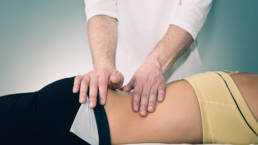What is Tennis Elbow?
Tennis elbow is a very broad term often used to describe pain or discomfort on the outside of the elbow that has occurred from the over use of musculature of the hand, wrist and forearm. The term “tennis elbow” was coined after a high proportion of tennis players had developed the condition, as they put the common tendon of the elbow under repeated stress.
However there are many other professions that experience this condition. Tennis elbow tends to occur in either an acute form or a more subtle form in which the muscles and tendons that attach around the outside of the elbow are injured. The bony part of the elbow (the lateral epicondyle) is where these muscles and tendons attach to permit movement of the hand and wrist.
Health professionals refer to tennis elbow as “lateral epicondylitis”, which refers to inflammation around the lateral epicondyle. There are other terms used to describe pain around the elbow, one of which is “golfer’s elbow”. This term is referring to pain on the inside of the elbow (medial epicondyle) and is also known as medial epicondylitis.
Tennis elbow most commonly affects people on their dominant side, or the side that is used for repeated gripping, resisting and movement at the wrist. Though it is possible for the condition to occur in both arms.
What are the Symptoms of Tennis Elbow?
Symptoms vary from person to person, but common presentations include:
- Aching or pain around the area of the lateral epicondyle that may slowly develop over time. The onset of pain can also occur quickly, but less commonly
- An ache or pain that is experienced during or after gripping or squeezing objects
- Aching or pain that is worsened by forcefully moving the wrist. Some activities may include handling kitchen utensils like using a knife to cut firm vegetables, opening a jar or a door, turning on the taps, using carpentry tools or gardening tools that require you to grip or twist and cleaning tables and windows.
Who gets Tennis Elbow?
Tennis elbow has been found to affect 1% to 3% of the population and the incidence among tennis players has been extremely high, with up to 50% of tennis players being affected during their careers.
Tennis elbow tends to occur in men more than women and is most commonly present among people between the ages of 30 and 50 years, however, Tennis Elbow can affect people of any age.
Despite being highly prevalent among tennis players, Tennis Elbow may affect anyone who participates in work or leisure activities that involves repetitive use of the elbow, hand and wrist, especially if there is a lot of force during gripping as part of the action.
How is Tennis Elbow diagnosed?
Tennis elbow can be diagnosed by your Physiotherapist. During the consultation, your Physiotherapist should ask you about how the pain started, the location of pain and what activities make it feel better or worse. After the Physiotherapist is satisfied they have enough information to proceed, they should take you through a series of tests to determine your source of pain.
They should feel your muscles and tendons in your forearm and measure your wrist movement. Your Physiotherapist should also feel around the elbow to determine the areas of tenderness and should ask you how your elbow feels upon certain movements including extending you wrist against resistance.
Only a small proportion of people require other imaging such as an ultrasound or CT. This will typically be because the symptoms may not fit the expected diagnosis, other structures may be involved, or a person may not be responding to the usual management of the condition.
Tennis elbow is successfully managed with Physiotherapy treatment and a rehabilitation program. Other possible treatment includes cortisone injections, and in severe cases, surgery if there is no improvement with conservative means.
The management of tennis elbow is tailored to an individual and will be influenced by your medical history, pain levels, hand and wrist function and other medications you are currently taking.
The goals of treatment are to:
- Decrease and eliminate pain, swelling and inflammation
- Promote healing around the muscle and tendon
- Change or modify the loads on the elbow
- Restore function, movement and strength to the elbow, forearm and wrist
How to Reduce Pain and Promote Healing of Tennis Elbow
Some modalities to reduce pain would include:
- Regular application of ice to the area
- Taping the elbow, as per your Physiotherapist’s instructions
- Taking anti-inflammatories (NSAIDS), in consultation with your GP
- Avoiding movements that cause unnecessary pressure or stress through the forearm muscles and elbow
When the pain and discomfort have begun to subside, your Physiotherapist will take your through some specific exercises to stretch and strengthen the muscles and tendons surrounding the elbow. There will be specific movements that you will be advised to avoid, including any activity that causes pain to the elbow either during or afterwards.
Your recovery may also be assisted with taping of the elbow / forearm or the use of a specific brace fitted by your Physiotherapist.
What is the recovery rate for People with Tennis Elbow?
Generally, 95% of people will make a full recovery with Physiotherapy treatment and management. Around 5% of people require surgical intervention to repair the muscle and tendon around the elbow. In the 5% who undergo surgery, 80-90% experience pain relief and restoration of function.
This article is by one of our affiliates, Sophie Halsall-McLennan from Fresh Start Physiotherapy Geelong.
Sophie Halsall-McLennan is the owner of Fresh Start Physiotherapy in the Geelong & Ocean Grove area. She is a specialist in treating back pain, has a Bachelor of Physiotherapy from Charles Sturt University and has over 11 years of clinical experience as a Physiotherapist. She is also a lecturer at Deakin University.
Related Posts
Sunday and After Hours Physiotherapy Appointments!
3 December 2019
The Perth Wellness Centre Physiotherapy Department has been providing its clients with quality weekend and after-hours service care for over 7 years. Our desire to care for the people of Perth ensures that we have a dedicated team member on standby to carry out Weekend, after-hours and Public…
0 Comments2 Minutes
What is Trigger Point Therapy?
31 January 2017
Trigger point therapy is a type of remedial massage practiced at Perth Wellness Centre. This massage method involves putting direct pressure on specific points on tender muscle tissues, known as trigger points, to help relieve pain and reduce muscle tension.
0 Comments1 Minute


